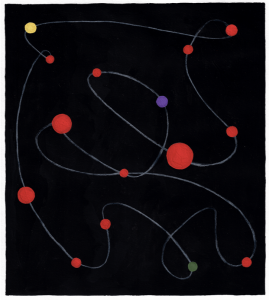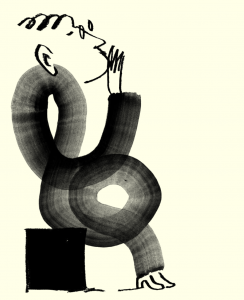After losing three of his limbs to an IED in Afghanistan, Betty Wood talks to the photographer about his return to the country that nearly killed him, and photographing the wounded Afghans he met there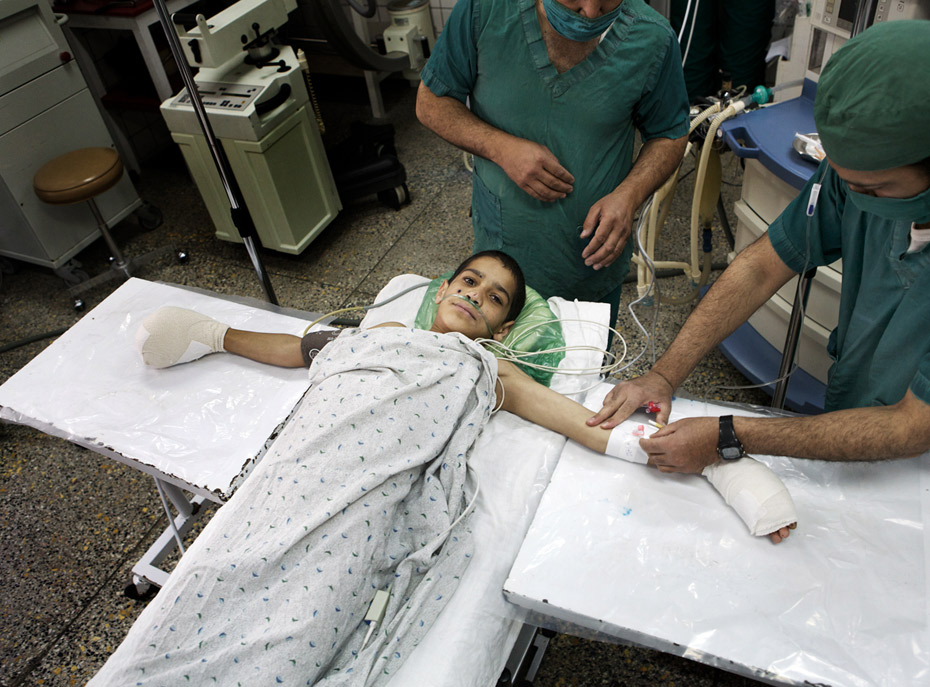
Above: “Sediqullah, 10, awaits surgery on his injured hands. His hands had been badly damaged when playing with a bomb fuse he’d found. He lost several fingers”
“I’d been going to war zones, places like Sudan, Angola and Congo for ten years before I went to Afghanistan” photographer Giles Duley tells me, taking a sip of tea from the kitsch mug he’s been handed. It features a garish portrait of the Duke and Duchess of Cambridge on their wedding day, and we both admire it for a moment, a light moment in a sombre context. We’re sat inside the gallery space at KK Outlet on Hoxton Square, getting ready to discuss his exhibition Afghanistan 2012, which has just opened to the public.
Documenting the impact of the Afghanistan invasion on its civilian population – specifically the wounded who’ve sustained injuries (and lost limbs) as a result of the war – the portraits are incredibly moving, and a stark reminder of the dangers of modern warfare, a reality Giles is intimately acquainted with. “(As a photographer) in some ways, being in Afghanistan in that situation (ie embedded with the military) was less risky than some of the other places I’d been. Like Congo for example – if I was to get injured there, no one would have come to get me. In Afghanistan, there were military helicopters and medics, so in a weird sort it way, it was a lot safer”. He pauses. “Well, perhaps not safer, but certainly if something were to happen to you, then there was help available!”
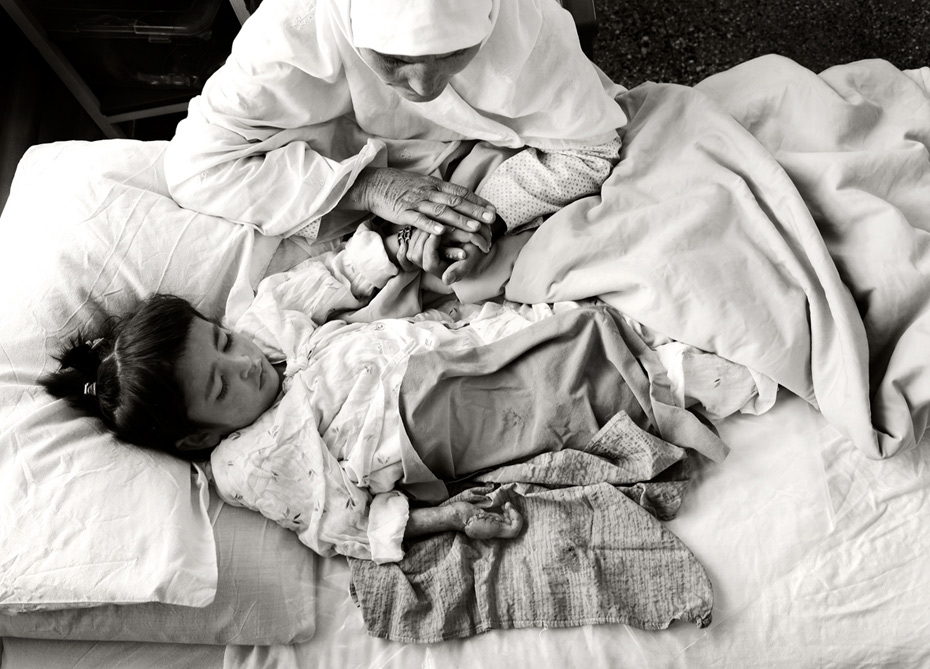
Above: “Mehdiai, 4, is watched over by her aunt at Emergency hospital. She lost part of her hand after an unexploded device that she brought home went off”
That something came early one morning in Kabul, February 2011 in the form of an IED. In the resulting explosion, Giles lost both of his legs and his left arm, and spent the next 45 days in the intensive care unit of Queen Elizabeth Hospital, Birmingham, fighting for his life. “Injured as I was, I was told I’d never live independently ever again. Very few people with my injuries actually make it, so the idea of going back to work again… Everyone was like, ‘Really?’”
After more than a year of intensive physiotherapy and recuperation, Giles moved beyond the idea of simply living independently: he’d learned to sit, then stand and walk again with the aid of prosthetics. He also re-learned how to shoot with his camera: “You use three things to balance, your feet, your inner ear and your eyesight. I lost both feet, and my inner ear was damaged, so I do everything by eyesight, now. It’s a bit awkward to shut one eye and take a picture so I sent a lot of time standing in a room with my eyes shut learning to balance again”. Learning to use his camera, like learning to walk, was a step towards fulfilling his larger goal: “I decided that I want to go back to Afghanistan, to carry on with the work I’d started there before I was injured.” Before his work documenting humanitarian crises, Giles spent a decade working as a fashion and music photographer. “I gave all that up because I felt it was really important to do something useful with my photography” he tells me, explaining at the same time the pull he felt to return to Afghanistan 18 months after his injuries. “I’m not a photojournalist, or a war reporter, I just use photography to give people a voice…”
In a twist of fate, it has been his own injuries that really helped him bring the experiences and individual stories of these people to the fore: “The irony of what happened to me is that I’m doing the same thing as before, it’s just that now a lot more people are taking notice of it. Since I was injured, people have wanted to interview me and tell my story. But there are other people out there with stories nobody’s listening to. I realised I had an opportunity to use what had happened to me to tell their stories. People ask if I regret going, well I don’t – not at all. I believe the principle of what I was doing was right and I felt a duty to carry on.”
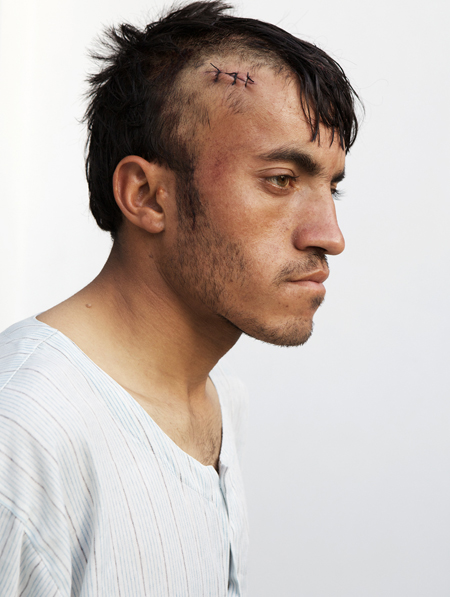
“A portrait of a policeman injured during a Taliban raid. He was a new recruit and was guarding a checkpoint when the Taliban attacked. His colleague tried to throw a grenade but in his panic he held onto it for too long, killing him and injuring those around him”. Carry on he did. In October 2012, Giles went back to Afghanistan, where he found that the treatment for Afghan amputees like himself was shockingly absent. “I guess you have to ask yourself why we went there – my understanding of it is that firstly, we wanted to make our country safer by getting rid of terrorism and secondly, stabilise Afghanistan for the Afghan people.”
Giles’ images tell the story of individuals like seven-year-old Ataqullah, who lost his arm and leg after stepping on a landmine walking to school. “There are 55’000 amputees in Afghanistan – you can’t even begin imagine how many people have died. How many children hide under tables every time they hear a plane going overhead, just traumatised? Have we done anything for that country? We haven’t even built one functioning hospital in the decade we’ve been there”.
When I ask about his anxiety in going back, and whether he achieved any sense of closure – as clumsy and ambiguous a question I could ask, and one I am embarrassed about posing – his response is earnest: “I’m not brave. You say to yourself ‘OK, chances are, nothing’s going to happen’. But something had happened before. As we were driving I found myself looking at every vehicle thinking, ‘Is it going to blow up?’ I couldn’t logically talk myself out of it. I can’t… But not to carry on… I would’ve felt it’d beaten me.”
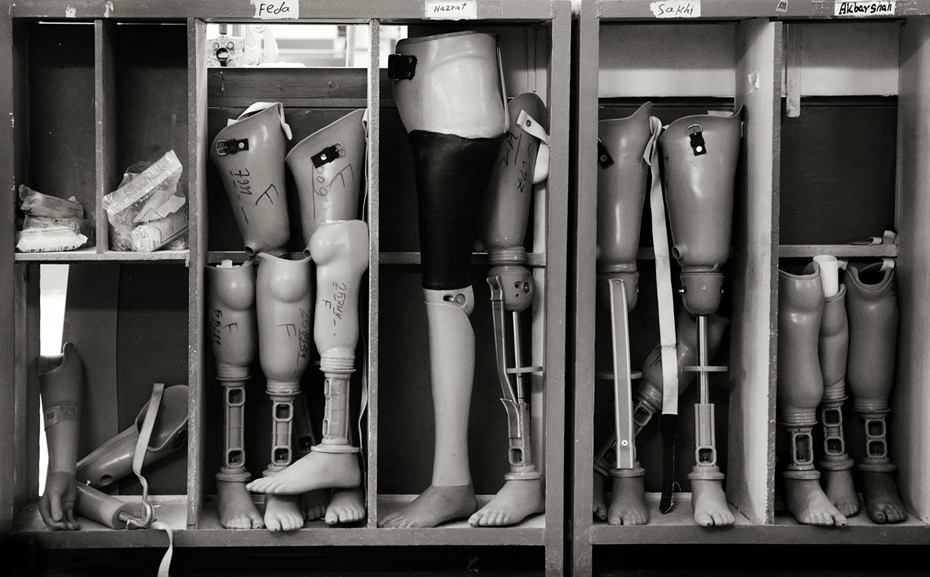
Above: Prosthetic limbs awaiting collection at the ICRC limb-fitting centre in Kabul. Since the programme started in 1988, the service has provided nearly 100,000 limbs
Perhaps the biggest sense of anxiety Giles struggles with in his work is ethical: “As a photographer I always felt I was doing the right thing , but as a human, it felt wrong somehow. It haunts me – but maybe now it makes it easier for the person I’m photographing: they see me and think ‘He’s been through something similar’. I was photographed by a Canadian photographer on the helicopter that picked me up when I was injured. I’m probably the only photographer who’s been through that exact experience and it might not make me any better, but it does give me a different perspective.” Certainly his images are testament to the empathy he feels for his sitters – the result is a haunting body of work that brings into focus the human consequence of the Afghanistan invasion.
